Bibim Guksu: A Fiery and Refreshing Bowl of Korean Spicy Cold Noodles 🍜🌶️✨
1. Introduction
Are you ready to tantalize your taste buds with a dish that perfectly balances heat, tanginess, and refreshing coolness? Look no further than Bibim Guksu, the iconic Korean spicy cold noodles. This vibrant and flavorful dish features thin wheat flour noodles tossed in a gochujang-based sauce, offering an explosion of flavors with every bite. Ideal for hot summer days or anyone craving a spicy kick, this bibim guksu recipe is surprisingly easy to make at home. With its delightful mix of textures and tastes, Bibim Guksu is a guaranteed crowd-pleaser. If you’re looking for more culinary inspiration, be sure to check out our other delicious recipes!
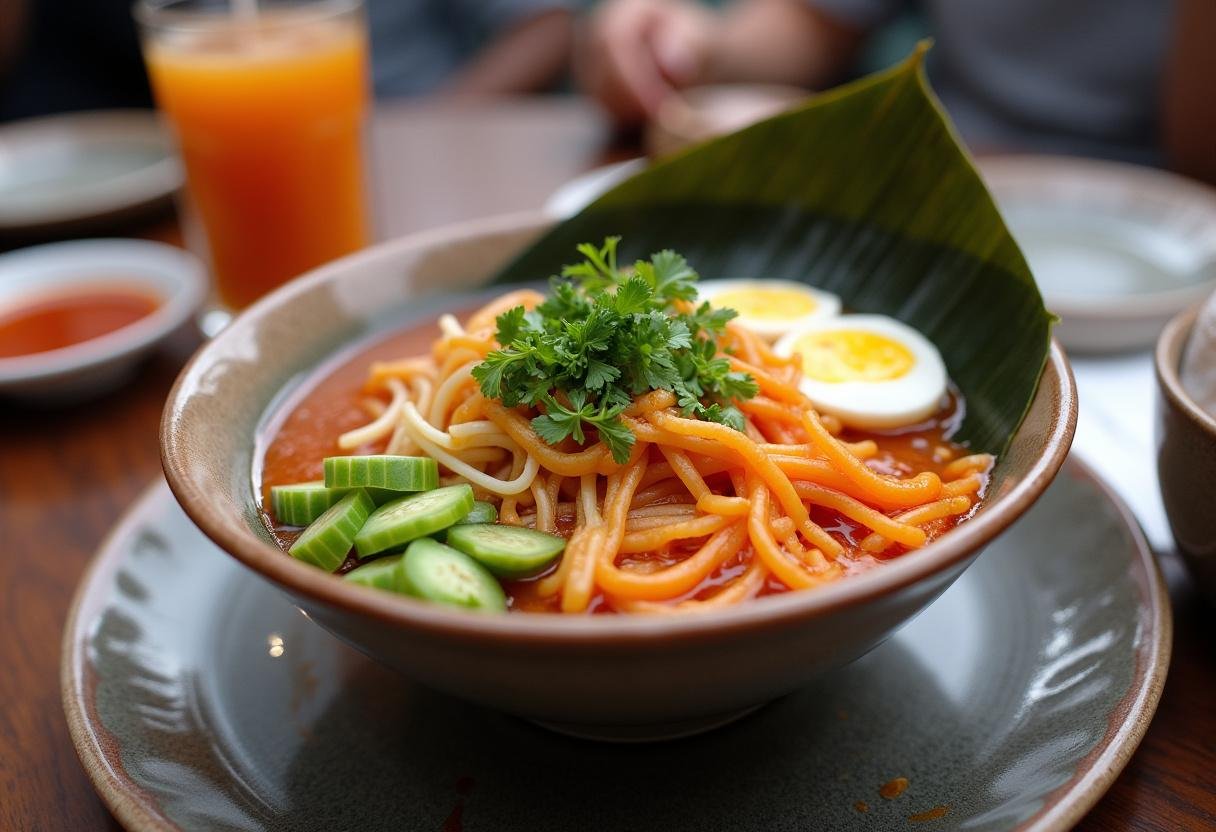
In this comprehensive guide, we’ll walk you through each step of creating the perfect bibim guksu recipe, from selecting the right ingredients to mastering the art of the gochujang sauce. Maybe you are also looking for recipe ideas for lunch? Check out our suggestions here. Whether you’re a seasoned Korean food enthusiast or a curious beginner, you’ll find everything you need to create an authentic and delicious bowl of spicy cold noodles. Hungry for more dinner options? You might like our guide for dinner recipe ideas. So, grab your apron and let’s dive into the world of Korean noodle salad!
2. Understanding Bibim Guksu
Bibim Guksu, often translated as “mixed noodles,” is a popular Korean dish known for its bold flavors and refreshing qualities. At its heart, it’s a simple combination of noodles, vegetables, and a spicy sauce. The magic lies in the balance of flavors – the sweetness of sugar, the tanginess of vinegar, the umami of soy sauce, and the fiery heat of gochujang, a fermented Korean chili paste. The versatility of bibim guksu recipe allows for endless customization, making it a favorite for both home cooks and restaurant chefs. It’s a fantastic dish, especially comparable to other noodle dishes found here.
Unlike warm noodle dishes like Japchae or Kalguksu, Bibim Guksu is served cold, making it an ideal choice for warmer weather. The cold temperature enhances the refreshing quality of the vegetables and balances the spiciness of the sauce, creating a harmonious culinary experience. The dish is not only delicious but also visually appealing, with its vibrant colors and textures. Speaking of visually appealing dishes, have you ever tried making Irish Soda Bread? You can find a recipe for a Rustic Irish Soda Bread with a Golden Crust here. With the right gochujang noodles, you can easily impress your family and friends.
3. Essential Ingredients for Authentic Bibim Guksu
To create an authentic bibim guksu recipe, you’ll need a few key ingredients. Here’s a breakdown:
- Noodles: Somyeon noodles are the traditional choice. These are thin, white wheat flour noodles that cook quickly and have a delicate texture. You can find them at most Asian grocery stores.
- Gochujang: This is the star of the sauce. Gochujang is a fermented Korean chili paste that provides a deep, savory, and spicy flavor.
- Gochugaru: Korean chili flakes add an extra layer of heat and a vibrant color to the dish.
- Vinegar: Rice vinegar is commonly used to provide a tangy contrast to the spicy and savory elements.
- Soy Sauce: Adds umami and depth to the sauce.
- Sugar: Balances the spiciness and acidity of the other ingredients.
- Garlic & Ginger: Essential aromatics that enhance the overall flavor profile.
- Sesame Oil: Adds a nutty aroma and richness.
- Vegetables: Common additions include cucumber, carrots, lettuce, and kimchi. Get creative and use what you have on hand!
- Egg: A hard-boiled egg, sliced or quartered, adds protein and a creamy texture.
- Sesame Seeds: For garnish, adding a nutty flavor and visual appeal.
Thinking about other delicious dishes you can make with similar ingredients? Our Succulent Garlic Herb Roast Beef with Caramelized Veggies recipe might also catch your eye!
4. Step-by-Step Bibim Guksu Recipe
Now, let’s get cooking! Follow these steps to create your own delicious bowl of spicy cold noodles.
Step 1: Prepare the Noodles and Vegetables
Bring a pot of water to a boil. Add the somyeon noodles and cook according to package directions, usually around 3-4 minutes. Once cooked, drain the noodles and rinse them thoroughly under cold water. This stops the cooking process and removes excess starch, preventing them from sticking together. Set the noodles aside.
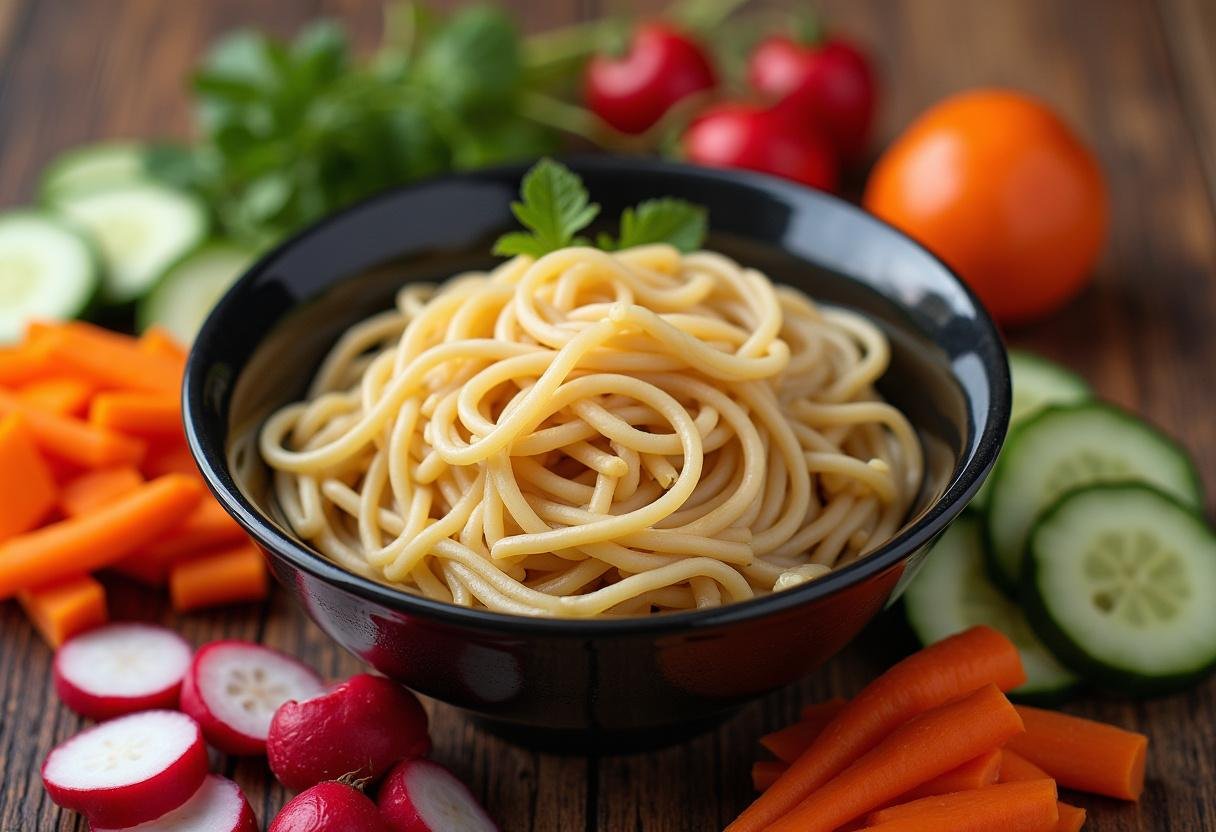
While the noodles are cooking, prepare your vegetables. Julienne the cucumber and carrots, and chop the lettuce or kimchi into bite-sized pieces. You can also add any other vegetables you like. Keep the vegetables chilled until ready to assemble. If you’re a fan of hearty, comforting meals, you might also enjoy our Rich Hearty British Cottage Pie with Creamy Mash!
Step 2: Make the Gochujang Sauce
In a bowl, whisk together the gochujang, gochugaru, rice vinegar, soy sauce, sugar, minced garlic, minced ginger, and sesame oil. Adjust the quantities to your liking, depending on your spice preference. Taste and adjust as needed. The sauce should be spicy, tangy, and slightly sweet. This gochujang noodles sauce is the heart of the dish, so take your time to perfect it. Need inspiration for other flavorful dishes? Try our Sweet Savory Slow Cooker Honey Glazed Gammon!
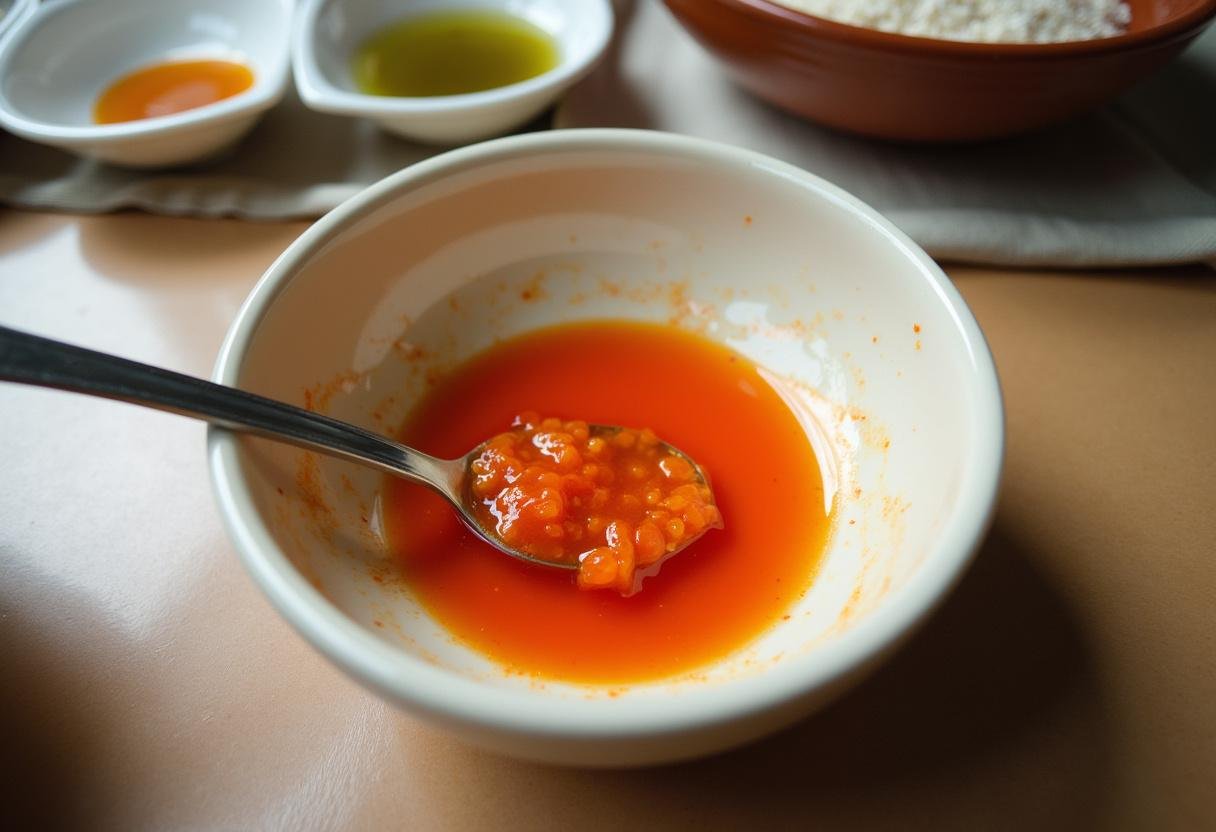
Step 3: Combine Noodles, Vegetables, and Sauce
In a large bowl, combine the cooked noodles, prepared vegetables, and the gochujang sauce. Toss everything together until the noodles and vegetables are evenly coated with the sauce. Make sure every strand of noodle is covered for maximum flavor.
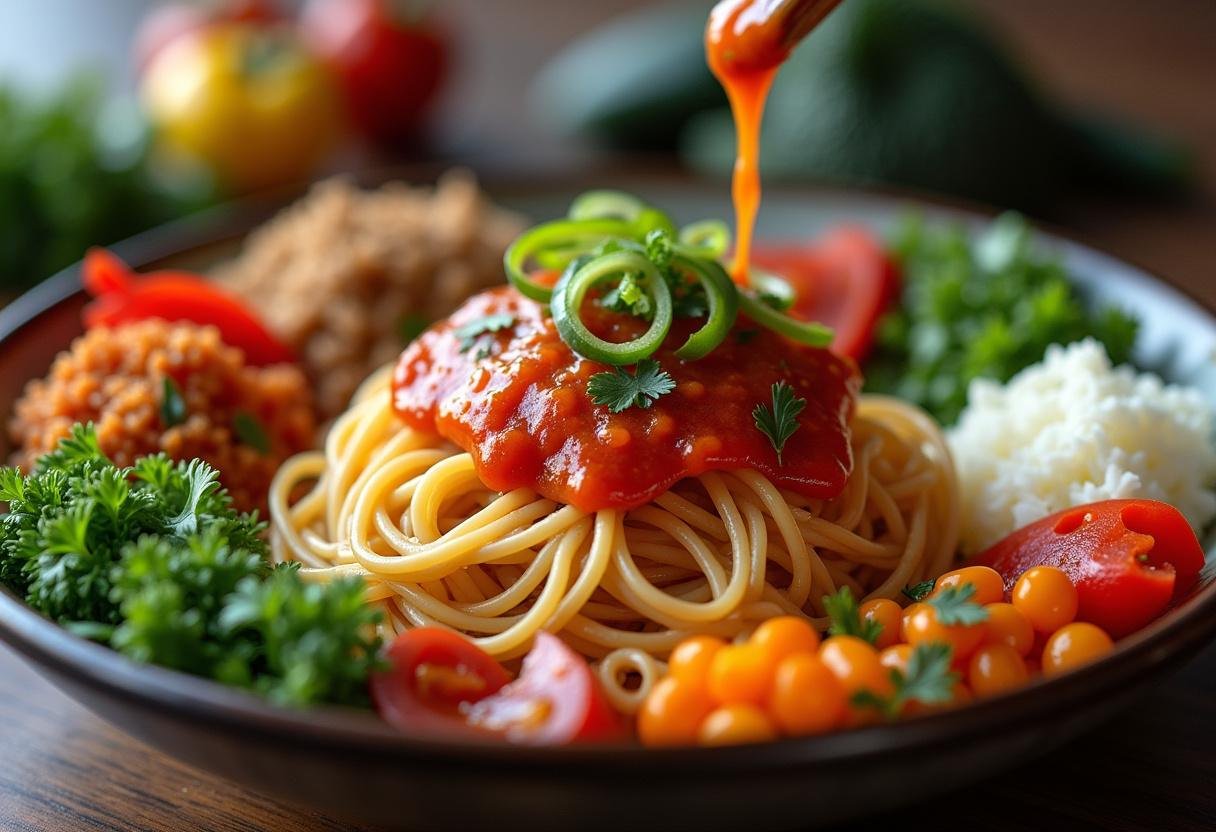
Step 4: Garnish and Serve
Transfer the spicy cold noodles to serving bowls. Garnish with sliced hard-boiled egg and a sprinkle of sesame seeds. You can also add a drizzle of sesame oil for extra flavor. Serve immediately and enjoy the refreshing and spicy flavors of Bibim Guksu! For another fulfilling meal idea, explore our recipe for Classic Lamb Mince Shepherd’s Pie.
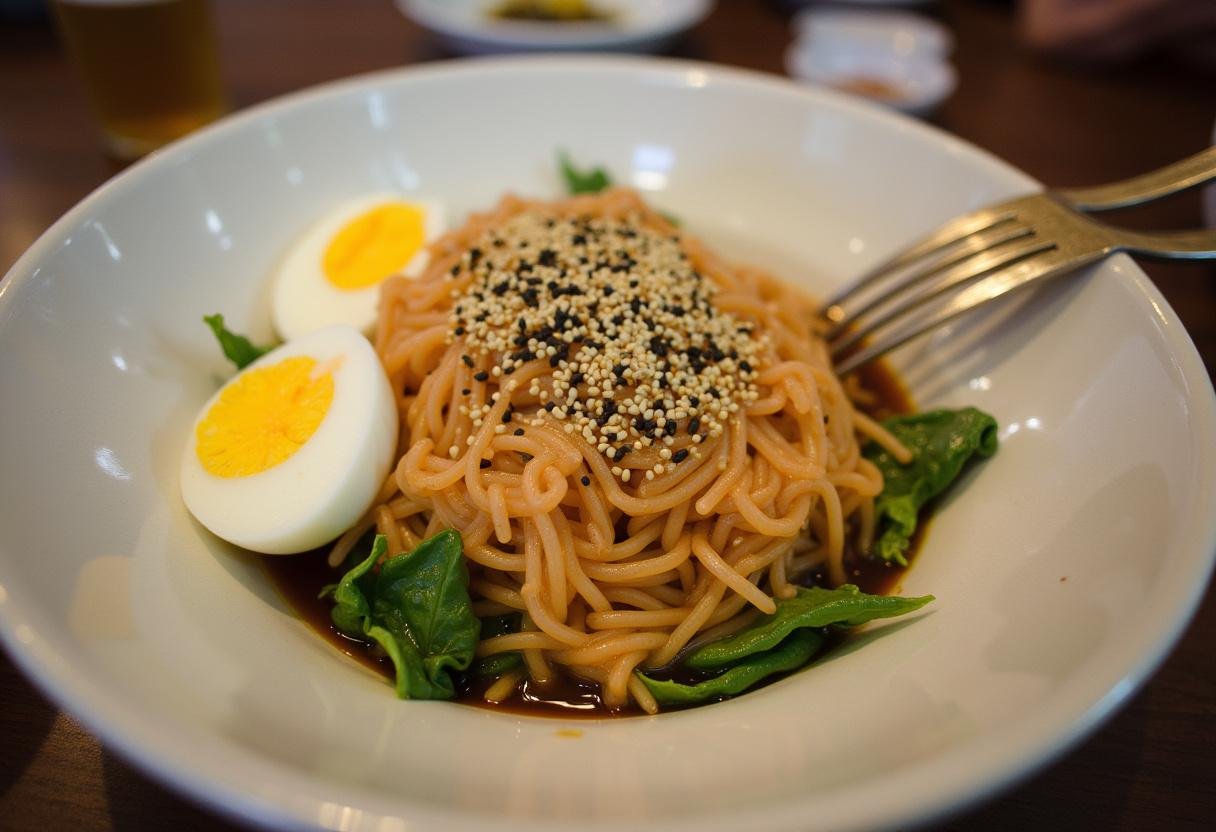
5. Tips and Variations for the Best Bibim Guksu
- Adjust the Spiciness: If you’re sensitive to spice, start with a smaller amount of gochujang and gochugaru, and add more to taste.
- Add Protein: Besides eggs, you can add sliced beef, grilled chicken, or tofu for extra protein.
- Get Creative with Vegetables: Feel free to add other vegetables like bean sprouts, spinach, or mushrooms.
- Kimchi is Key: Adding kimchi not only enhances the flavor but also adds a satisfying crunch.
- Make it Vegan: Substitute honey or maple syrup for sugar and omit the egg to make a vegan version.
- Use Different Noodles: If you can’t find somyeon noodles, you can use other thin wheat noodles or even glass noodles.
6. Serving Suggestions for Bibim Guksu
Bibim Guksu is perfect as a standalone meal, but it also pairs well with other Korean dishes. Here are some serving suggestions:
- Korean BBQ: Serve Bibim Guksu as a side dish with grilled meats like bulgogi or galbi.
- Dumplings (Mandu): Enjoy it with steamed or fried dumplings for a complete meal.
- Korean Fried Chicken: The spiciness of the noodles complements the crispy, savory chicken perfectly.
- Kimchi Pancakes (Kimchijeon): Serve Bibim Guksu alongside kimchi pancakes for a flavorful and satisfying combination.
Looking for other options for celebratory meals? Consider our recipe for St. Patrick’s Day Dinner: Irish Sausages with Colcannon Mash!
7. Health Benefits of Bibim Guksu
Besides being delicious, Bibim Guksu offers several health benefits:
- Rich in Nutrients: The vegetables provide essential vitamins and minerals.
- Source of Probiotics: If you add kimchi, you’ll get a dose of beneficial probiotics.
- Fiber-Rich: The noodles and vegetables contribute to your daily fiber intake, aiding digestion.
- Low in Fat: Bibim Guksu is relatively low in fat, especially if you use lean protein sources.
- Spicy Kick: Capsaicin in chili peppers has been linked to various health benefits, including pain relief and improved metabolism.
And if you’re in the mood for more cozy comfort food, don’t miss our recipe for Slow-Cooked Lamb Rosemary Pies – a perfect way to warm up on a chilly evening!
8. Common Mistakes to Avoid
To ensure your Bibim Guksu turns out perfectly, avoid these common mistakes:
- Overcooking the Noodles: Overcooked noodles will be mushy and unappetizing. Cook them al dente and rinse them thoroughly.
- Not Balancing the Sauce: The sauce should be a harmonious blend of spicy, sweet, tangy, and savory. Adjust the ingredients to your liking.
- Using Low-Quality Gochujang: Invest in a good quality gochujang for the best flavor.
- Not Chilling the Noodles: Cold noodles are essential for the refreshing quality of the dish.
- Adding Too Much Sauce: Start with a smaller amount of sauce and add more as needed to avoid overpowering the other ingredients.
9. Conclusion
Bibim Guksu, with its vibrant flavors and refreshing coolness, is a culinary adventure worth embarking on. This spicy cold noodles dish is easy to customize, making it a versatile option for any palate. By following this comprehensive guide, you can create an authentic and delicious bowl of Korean noodle salad that will impress your family and friends. So, gather your ingredients, put on your apron, and get ready to enjoy a fiery and refreshing taste of Korea!
Print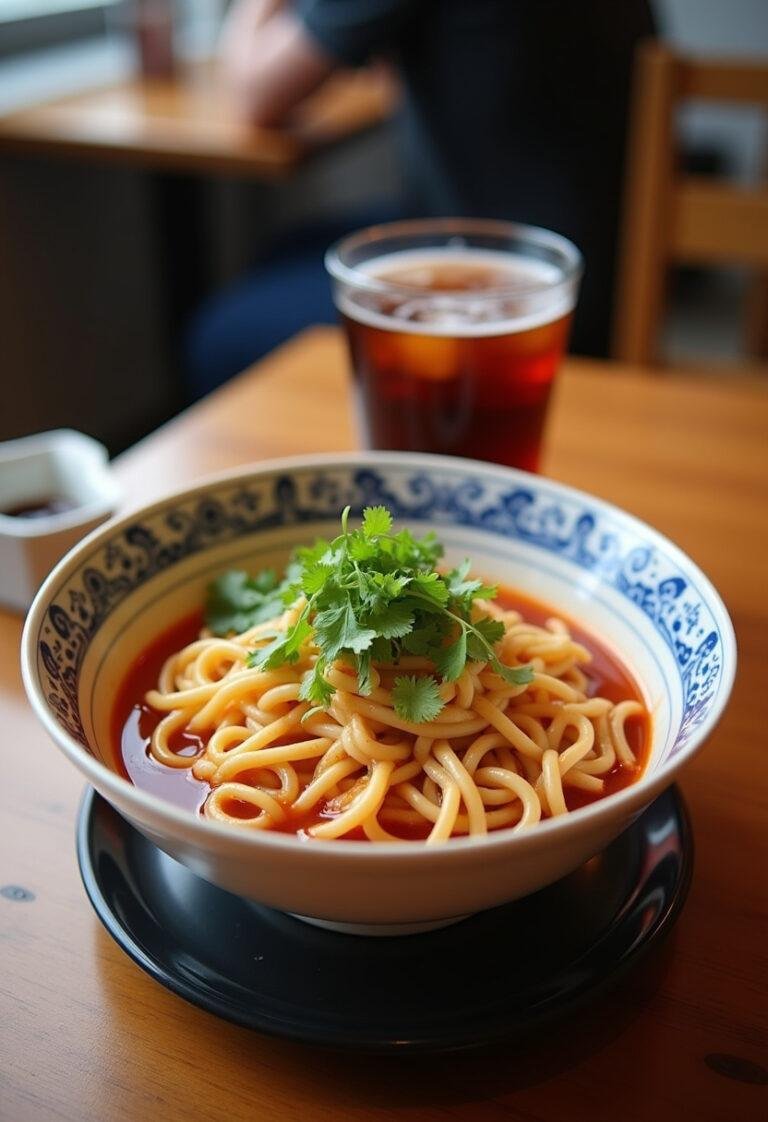
Bibim Guksu: Spicy Korean Cold Noodles with Tangy Gochujang Sauce
Discover the vibrant and delicious world of Bibim Guksu, a traditional Korean dish featuring spicy cold noodles tossed in a tangy gochujang-based sauce. This refreshing meal is perfect for hot days and is sure to impress with its delightful mix of flavors and textures.
- Total Time: 14 minutes
- Yield: 2 servings
Ingredients
- Somyeon noodles
- Gochujang (Korean chili paste)
- Gochugaru (Korean chili flakes)
- Rice vinegar
- Soy sauce
- Sugar
- Minced garlic
- Minced ginger
- Sesame oil
- Cucumber, julienned
- Carrots, julienned
- Lettuce, chopped
- Kimchi (optional)
- Hard-boiled egg, sliced
- Sesame seeds for garnish
Instructions
- Boil water and cook somyeon noodles for 3-4 minutes. Drain and rinse under cold water.
- Prepare your vegetables by julienning cucumber and carrots, and chop lettuce or kimchi.
- In a bowl, whisk together gochujang, gochugaru, rice vinegar, soy sauce, sugar, garlic, ginger, and sesame oil to make the sauce.
- Combine the cold noodles, vegetables, and sauce in a large bowl. Toss until evenly coated.
- Garnish with sliced hard-boiled egg and sesame seeds. Serve immediately.
Notes
- Adjust spiciness by modifying gochujang and gochugaru amounts.
- Add protein like sliced beef, grilled chicken, or tofu if desired.
- Get creative with vegetables like bean sprouts or spinach.
- Kimchi adds great flavor and crunch; consider its addition.
- For a vegan version, omit the egg and substitute honey with maple syrup.
- Prep Time: 10 minutes
- Cook Time: 4 minutes
- Category: Main Course
- Method: No-cook
- Cuisine: Korean
- Diet: Vegan option available
Nutrition
- Serving Size: One serving
- Calories: 320 Kcal
- Sugar: 5g
- Sodium: 600mg
- Fat: 10g
- Saturated Fat: 1g
- Unsaturated Fat: 8g
- Trans Fat: 0g
- Carbohydrates: 48g
- Fiber: 4g
- Protein: 10g
- Cholesterol: 70mg


[…] your friends and family! After you have this great dish, try something a little more exotic like Bibim Guksu Spicy Korean Cold Noodles. […]
[…] eternally classic dish! Why not try some other easy recipes like Crispy Parmesan Cauliflower Bites, Bibim Guksu Spicy Korean Cold Noodles, Dad’s Famous Fish Stew, Crispy Chicken with Fresh Mozzarella or Golden Cheesy Butternut Squash […]
[…] this soup, regardless of their cooking expertise. Craving something different? Why not try these Spicy Korean Cold Noodles. Thirdly, prepare yourself for an explosion of flavor. The fantastic combination of savory Italian […]